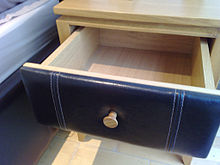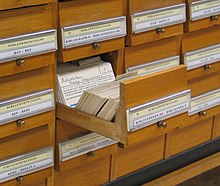drawer

A drawer (regional drawer or " drawer ", especially Austrian , just "drawer") is a container that is open at the top and can be pulled out horizontally from a cupboard or chest of drawers and is usually stored on side rails .
Almost all drawers have a handle at the front . Alternatively, the drawer can be opened by pressing the front panel using a spring mechanism. Drawers can be secured with a lock . There are often lockable drawers on desks .
In addition to the classic angular interior shape, drawers can be trough-shaped as a chute to store bulk goods such as sugar , flour or salt .
Special forms, mostly on castors , are located as storage compartments under beds or as roll containers that contain several drawers under office desks.
history
No drawers are known from antiquity or the high Middle Ages; only wooden chests were used for storage , into which the objects were placed from above. Drawers only appeared with the development of cupboards and chests of drawers in the late Middle Ages or in the Renaissance . Once invented, they found use in numerous areas of application.
Telescopic rails and self-closing
In modern furniture, especially in fitted kitchens , drawers are often equipped with telescopic rails that make opening and closing the drawers easier due to the reduced friction of these systems.
Some drawers have a self-closing mechanism, among other things marketed as "soft-close". The self-closing mechanism causes the drawer to close the last piece by itself. It is a mechanism that, roughly speaking, consists of a spring and a damper. When the drawer is opened, the spring is tensioned and the damping is extended. If the drawer is opened to about a quarter, the self-closing locks without preventing the drawer from opening further. When closing, the self-closing mechanism releases itself from the lock and pulls the drawer in by itself. The cushioning ensures that the drawer does not spring back despite the tensioned spring, but closes gently.
Surrounding magnetic strips in the frame and on the drawers are a more complex version of the self-closing mechanism. This eliminates the signs of fatigue caused by self-retraction by means of springs in the rails. For cost reasons, these are only found in the upper price segment, for example in private kitchens made of stainless steel.
Drawers on electronic devices
Electronic devices such as CD players , DVD players , CD and DVD drives and other technical and electronic devices are now often provided with a drawer drive. The drawer is usually opened and closed by means of a remote control whose signal starts the drive motor of a rack and pinion drive and thus triggers the forward or return stroke of the drawer. If the target position of the drawer is reached, z. B. a limit switch off the drive motor again.
Drawers in art
Paul Cézanne painted the still life shown here with an open drawer . The painting Burning Giraffe by Salvador Dalí , which is colloquially often referred to as the “drawer woman”, is probably even better known .
"Drawer" in the figurative sense
"Pigeonhole thinking" disparagingly denotes an attitude of too rigid classifications, as does the verb "drawer". In the Romandie (French-speaking Switzerland), the verb "relapsing ladiser" within the meaning of is "to files put" or, with a negative connotation, "push on the back burner" used. Written “for the drawer” are texts by an author that were intended for publication but that did not take place.
See also
Web links
Individual evidence
- ↑ Document on different drawer designs (PDF; 472 kB) August 18, 2013
- ↑ Jens Förster: A short introduction to pigeonhole thinking , Random House 2009, ISBN 3-641-03194-X

